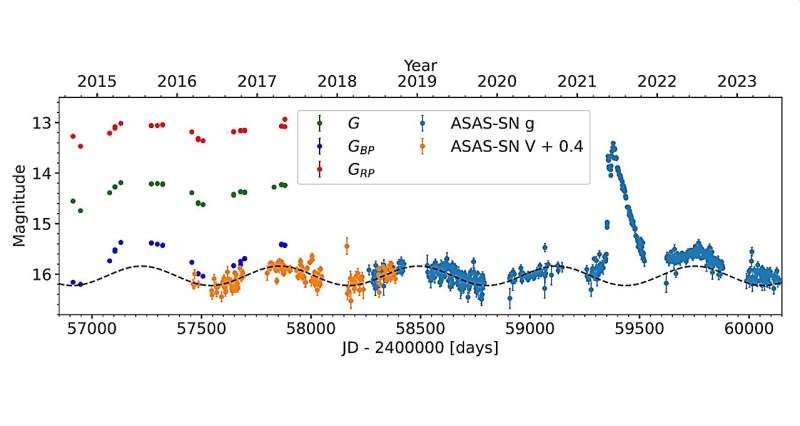December 11, 2023 report
This article has been reviewed according to Science X's editorial process and policies. Editors have highlighted the following attributes while ensuring the content's credibility:
fact-checked
peer-reviewed publication
trusted source
proofread
TCP J1822 is a symbiotic star, observations find

Using the Himalayan Chandra Telescope (HCT), Indian astronomers have conducted spectroscopic observations of a star discovered in 2021, known as TCP J1822. Results of the observational campaign indicate that TCP J1822 is a symbiotic star. The finding was published in the December issue of the Monthly Notices of the Royal Astronomical Society.
Symbiotic stars, which are among the widest interacting binaries, showcase dramatic, episodic changes in the spectra of their light because one of the pair is a very hot, small star, while the other is a cool giant. These systems may deliver essential information for researchers studying aspects of stellar evolution.
Located some 26,000 light years away, TCP J18224935-2408280, or TCP J1822 for short, was discovered on May 19, 2021 during an outburst. It is estimated that the outburst started between May 13 and 16, reaching the first maximum in about five days, which was followed by a 10-day-long slight decrease of brightness by 0.5 mag.
Follow-up observations of TCP J1822 found that it exhibits long-term variability and showcases strong neutral lines of hydrogen, helium, and a doubly ionized line of oxygen. All in all, the results suggested the symbiotic nature of TCP J1822 and its infrared colors are consistent with an S-type symbiotic star.
In order to confirm this hypothesis, L. S. Sonith and U. S. Kamath of the Indian Institute of Astrophysics in Bengaluru, decided to employ HCT's Himalayan Faint Object Spectrograph Camera (HFOSC) to low-resolution optical spectra of TCP J1822.
"The optical spectrum of TCP J1822 shows Balmer series lines, O I, He I, and high excitation lines such as He II, O[III], Raman scattered O VI and TiO band heads from the cool component, which unambiguously confirm the symbiotic nature of the system," the researchers explained.
Furthermore, the observations found that after returning to quiescence, TCP J1822 exhibits a temperature of above 100,000 K and luminosity at a level of 1,000 solar luminosities. These values are typical for the hot component (most likely a white dwarf) in quiescently burning symbiotic stars.
When it comes to the cooler component of the TCP J1822 system, the collected data indicate that it is a star of spectral type M1-2 III with a temperature of about 3,600 K. The star is some 69 times larger than the sun and has a luminosity of about 700 solar luminosities.
According to the study, TCP J1822 exhibits a combination nova type outburst. This is due to the fact that the outburst started as an accretion disk instability and ended in shell burning and expansion of photospheric radius of the white dwarf.
The observations also found that the pre- and post-outburst light curve of TCP J1822 displays a periodicity of approximately 631.25 days, which, according to the authors of the paper, is an orbital period of the system.
More information: L. S. Sonith and U. S. Kamath, TCP J18224935-2408280: a symbiotic star identified during outburst, Monthly Notices of the Royal Astronomical Society (2023). DOI: 10.1093/mnras/stad3121.
Journal information: Monthly Notices of the Royal Astronomical Society
© 2023 Science X Network



















